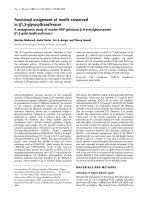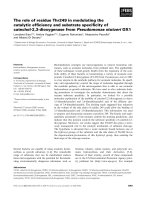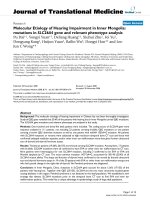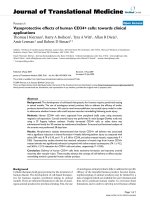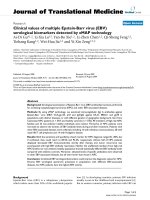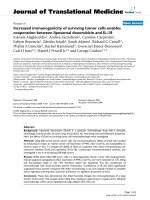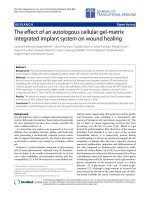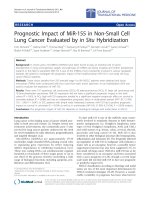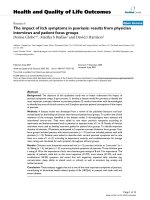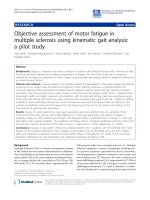Báo cáo hóa học: " Vector Quantization of Harmonic Magnitudes in Speech Coding Applications—A Survey and New Technique" pot
Bạn đang xem bản rút gọn của tài liệu. Xem và tải ngay bản đầy đủ của tài liệu tại đây (873.02 KB, 13 trang )
EURASIP Journal on Applied Signal Processing 2004:17, 2601–2613
c
2004 Hindawi Publishing Corporation
Vector Quantization of Harmonic Magnitudes in Speech
Coding Applications—A Survey and New Technique
Wai C. Chu
Media Laboratory, DoCoMo Communications Laboratories USA, 181 Metro Drive, Suite 300, San Jose, CA 95110, USA
Email:
Received 29 October 2003; Revised 2 June 2004; Recommended for Publication by Bastiaan Kleijn
A harmonic coder extracts the harmonic components of a signal and represents them efficiently using a few parameters. The
principles of harmonic coding have become quite successful and several standardized speech and audio coders are based on it.
One of the key issues in harmonic coder design is in the quantization of harmonic magnitudes, where many propositions have
appeared in the literature. The objective of this paper is to provide a survey of the various techniques that have appeared in the
literature for vector quantization of harmonic magnitudes, with emphasis on those adopted by the major speech coding standards;
these include constant magnitude approximation, partial quantization, dimension conversion, and variable-dimension vector
quantization (VDVQ). In addition, a refined VDVQ technique is proposed where experimental data are provided to demonstrate
its effectiveness.
Keywords and phrases: harmonic magnitude, vector quantization, speech coding, variable-dimension vector quantization, spec-
tral distortion.
1. INTRODUCTION
A signal is said to be harmonic if it is generated by a series
of sine waves or harmonic components where the frequency
of each component is an integer multiple of some funda-
mental frequency. Many signals in nature—including certain
classes of speech and music—obey the harmonic model and
can be specified by three sets of parameters: fundamental fre-
quency, magnitude of e ach harmonic component, and phase
of each harmonic component. In practice, a noise model is
often used in addition to the harmonic model to yield a high-
quality representation of the signal. One of the fundamental
issues in the incorporation of harm onic modeling in coding
applications lies in the quantization of the magnitudes of the
harmonic components, or harmonic magnitudes;manytech-
niques have been developed for this purpose and are the sub-
jects of this paper.
The term harmonic coding was probably first introduced
by Almeida and Tribolet [1], where a speech coder operat-
ing at a bit ra te of 4.8 kbps is described. For the purpose of
this paper we define a harmonic coder as any coding scheme
that explicitly transmits the fundamental frequency and har-
monic magnitudes as part of the encoded bit stream. We
use the term harmonic analysis to signify the procedure in
which the fundamental frequency and harmonic magnitudes
are extracted from a given signal.
As explained previously, in addition to the harmonic
magnitudes, two additional sets of parameters are needed to
complete the model. Encoding of fundamental frequency is
straig htforward and in speech coding it is often the period
that is being transmitted with uniform quantization. Uni-
form quantization for the period is equivalent to nonuni-
form quantization of the frequency, with higher resolution
for low frequency values; this approach is advantageous from
a perceptual perspective, since sensitivity toward frequency
deviation is higher in the low-frequency region. Phase infor-
mation is often discarded in low bit rate speech coding, since
sensitivity of the human auditory system toward phase dis-
tortions is relatively low. Note that in practical deployment
of coding systems, a gain quantity is transmitted as part of
the bit stream, and is used to scale the quantized harmonic
magnitudes to the target power levels.
The harmonic model is an attractive solution to many
signal coding applications, w ith the objective being an eco-
nomical representation of the underlying signal. Figure 1
shows two popular configurations for harmonic coding, with
the difference being the signal subjected to harmonic analy-
sis, which can be the input signal or the excitation signal ob-
tained by inverse filtering through a linear prediction (LP)
analysis filter [2, page 21]; the latter configuration has the
advantage that the variance of the harmonic magnitudes is
greatly reduced after inverse filtering, leading to more ef-
ficient quantization. Once the fundamental frequency and
the harmonic magnitudes are found, they are quantized and
grouped together to form the encoded bit stream. In the
present work we consider exclusively the configuration of
2602 EURASIP Journal on Applied Signal Processing
Signal
Harmonic
analysis
Other
processing
Fundamental
frequency
Harmonic
magnitudes
Other
parameters
Quantize
and
multiplex
Encoded
bit stream
Signal
Inverse
filter
LP
analysis
Harmonic
analysis
Other
processing
Fundamental
frequency
Harmonic
magnitudes
Other
parameters
Quantize
and
multiplex
Encoded
bit stream
Figure 1: Block diagrams of harmonic encoders, with harmonic analysis of the signal (top), and with harmonic analysis of the excitation
(bottom).
harmonic analysis of the excitation, since it has achieved re-
markable success and is a dopted by various speech coding
standards.
In a typical harmonic coding scheme, LP analysis is per-
formed on a frame-by-frame basis; the prediction-error (ex-
citation) signal is computed, which is windowed and con-
verted to the frequency domain via fast Fourier transform
(FFT). An estimate of the fundamental period T (measured
in number of samples) is found either from the input signal
or the prediction error and is used to locate the magnitude
peaks in the frequency domain; this leads to the sequence
x
j
, j = 1, 2, , N(T), (1)
containing the magnitude of each harmonic; we further as-
sume that the magnitudes are expressed in dB; N(T) is the
number of harmonics given by
N(T) =
α ·
T
2
(2)
with · denoting the floor function (returning the largest
integer that is lower than the operand) and α a constant that
is sometimes selected to be slightly lower than one so that the
harmonic component at ω = π is excluded. The correspond-
ing frequency values for each harmonic component are
ω
j
=
2πj
T
, j = 1, 2, , N(T). (3)
As we can see from (2), N(T) depends on the fundamen-
tal period; a typical range of T for the coding of narrow-
band speech (8 kHz sampling) is 20 to 147 samples (or 2.5 to
18.4 milliseconds) encodable with 7 bits, leading to N(T) ∈
[9, 69] when α = 0.95.
Various approaches can be deployed for the quantization
of the harmonic magnitude sequence (1). Scalar quantiza-
tion, for instance, quantizes each element individually; how-
ever, vector quantization (VQ) is the preferred approach for
modern low bit rate speech coding algorithms due to im-
proved p erformance. Traditional VQ designs are targeted at
fixed-dimension vectors [3]. More recently researchers have
looked into v ariable dimension designs, where many inter-
esting variations exist.
Harmonic modeling has exerted a great deal of influence
in the development of speech/audio coding algorithms. The
federal standard linear prediction coding (LPC or LPC10) al-
gorithm [4], for instance, is a crude harmonic coder where all
harmonic magnitudes are equal for a certain frame; the fed-
eral standard mixed excitation linear prediction (MELP) al-
gorithm [5, 6], on the other hand, uses VQ where only the
first ten harmonic magnitudes are quantized; the MPEG4
harmonic vector excitation coding (HVXC) algorithm uses
an interpolation-based dimension conversion method where
the variable-dimension vectors are converted to fixed dimen-
sion before quantization [7, 8]. The previously described
algorithms are all standardized coders for speech. An ex-
ample for audio coding is the MPEG4 harmonic and indi-
vidual lines plus noise (HILN) algor ithm, w here the trans-
fer function of a variable-order all-pole system is used to
capture the spectral envelope defining the harmonic magni-
tudes [9].
In this work a review of the existent techniques for
harmonic magnitude VQ is given, with emphasis on those
adopted by standardized coders. Weaknesses of past method-
ologies are analyzed and the variable-dimension vector
quantization (VDVQ) scheme developed by Das et al. [10]is
described. A novel VDVQ configuration that is advantageous
Vector Quantization of Harmonic Magnitudes 2603
for low codebook dimension is introduced and is based on
interpolating the elements of the quantization codebook.
The rest of the paper is organized as follows: Section 2 re-
views existent spectral magnitudes quantization techniques;
Section 3 describes the foundation of VDVQ; Section 4 pro-
poses a new technique called interpolated VDVQ or IVDVQ,
with the experimental results given in Section 5, some con-
clusion is included in Section 6.
2. APPROACHES TO HARMONIC
MAGNITUDE QUANTIZATION
This section contains a review of the major approaches for
harmonic magnitude quantization found in the literature.
Throughout this work we rely on the widely used spectral
distortion (SD) measure [2, page 443] as a performance in-
dicator for the quantizers, modified to the case of harmonics
and given by
SD =
1
N(T)
N(T)
j=1
x
j
− y
j
2
(4)
with x and y the magnitude sequences to be compared, where
the values of the sequences are in dB.
2.1. Constant magnitude approximation
The federal standard version of LPC coder [4]relieson
a periodic uniform-amplitude impulse train excitation to
the synthesis filter for voiced speech modeling. The Fourier
transform of such an excitation is an impulse train with con-
stant magnitude, hence the quantized magnitude sequence,
denoted by y, consists of one value:
y
j
= a, j = 1, 2, , N(T). (5)
It can be shown that
a
=
1
N(T)
N(T)
j=1
x
j
(6)
minimizes the SD measure (4); that is, the optimal solution
is given by the arithmetic mean of the target sequence in log
domain. The approach is very simple and in practice pro-
vides reasonable quality with low requirement in bit rate and
complexity.
A similar approach was used by Almeida and Tribolet
[1] in their 4.8 kbps harmonic coder. Even though the coder
produced acceptable quality, they found that some degree of
magnitude encoding, at the expense of higher bit rate (up
to 9.6 kbps), elevated the quality. This is expected since the
harmonic magnitudes for the prediction-error signal are in
general not constant. Techniques that take into account the
nonconstant nature of the magnitude spectrum are described
next.
2.2. Quantization to a partial group
of harmonic magnitudes
The federal standard version of MELP coder [5, 6] incorpo-
rates a ten-dimensional VQ at 8-bit resolution for harmonic
magnitudes, where only the first ten harmonic components
are transmitted. In the decoder side, voiced excitation is gen-
erated based on the quantized harmonic magnitudes and the
procedure is capable of reproducing with accuracy the first
ten harmonic magnitudes, with the rest having the same con-
stant value. In an ideal situation the quantized sequence is
y
j
= x
j
, j = 1, 2, , 10, (7)
y
j
= a, j = 11, , N(T), (8)
with the assumption that N(T) > 10; according to the model,
SD is minimized when
a =
1
N(T) − 10
N(T)
j=11
x
j
. (9)
In practice (7) cannot be satisfied due to finite resolution
quantization. This approach works best for speech with low
pitch period (female and children), since lower distortion
is introduced when the number of harmonics is small. For
male speech the distortion is proportionately larger due to
the higher number of harmonic components. Justification of
the approach is that the perceptually important components
are often located in the low-frequency region; by transmit-
ting the first ten harmonic magnitudes, the resultant quality
should be better than the constant magnitude approximation
method used by the LPC coder.
2.3. Variable-to-fixed-dimension conversion via
interpolation or linear transform
Converting the variable-dimension vectors to fixed-
dimension ones using some form of transformation that
preserves the general shape is a simple idea that can be
implemented efficiently in pract ice. The HVXC coder
[7, 8, 11, 12] relies on a double-interpolation process, where
the input harmonic vector is upsampled by a factor of eight
and interpolated to the fixed dimension of the VQ equal to
44. A multistage VQ (MSVQ) having two stages is deployed
with 4 bits per stage. Together with a 5-bit gain quantizer,
a total of 13 bits are assigned for harmonic magnitudes.
After quantization, a similar double-interpolation procedure
is applied to the 44-dimensional vector so as to convert it
back to the original dimension. The described scheme is
used for operation at 2 kbps; enhancements are added to
the quantized vector when the bit rate is 4 kbps. A similar
interpolation technique is reported in [13], where weighting
is introduced during distance computation so as to put more
emphasis on the formant regions of the LP synthesis filter.
The general idea of dimension conversion by transform-
ing the input vector to fixed dimension before quantization
can be formulated with
y
= B
N
x, (10)
2604 EURASIP Journal on Applied Signal Processing
where the input vector x of dimension N is converted to the
vector y of dimension M through the matr ix B
N
(of dimen-
sion M × N). In general M = N and hence the matrix is
nonsquare. The transformed vector is quantized with an M-
dimensional VQ, resulting in the quantized vector y,which
is mapped back to the original dimension leading to the final
quantized v ector
x = A
N
y (11)
with A
N
an N × M matrix. The described approach is known
as nonsquare transform [14, 15], and optimality criterion
can be found for the matrices A
N
and B
N
. Similar to the
case of partial quantization, the method is more suitable for
low dimension, since the transformation process introduces
losses that are not reversible. However, by elevating M, the
losses can be reduced at the expense of higher computational
cost. In [16], a harmonic coder operating at 4 kbps is de-
scribed, where the principle of nonsquare transform is used
to design a 14-bit MSVQ; a similar design appears in [17].
In [18] a quantizer is described where the variable-
dimension vectors are transformed into a fixed dimension of
48 using discrete cosine transform (DCT), and is quantized
using two codebooks: the transform or matrix codebook and
the residual codebook, with the quantized vector given by the
product of a matrix found from the first codebook and a vec-
tor found from the second codebook. A variation of the de-
scribed scheme is given in [19], which is part of a sinusoidal
coder operating at 4 kbps. Another DCT-based quantizer is
describedin[20]. To take advantage of the correlation b e-
tween adjacent frames, some quantizers combine dimension
conversion within a predictive framework; for instance, see
[21].
2.4. Multi-codebook
One possible way to deal with the vectors of varying dimen-
sion is to provide separate codebooks for different dimen-
sions; for instance, one codebook per dimension is an effec-
tive solution at the expense of elevated storage cost. In [22]
an MELP coder operating near 4 kbps is described where the
harmonic magnitudes are quantized using a switched pre-
dictive MSVQ having four codebooks. Two codebooks are
used for magnitude vectors of dimension less than 55, and
the other two for magnitude vectors of dimension greater
than 45; the ranges overlap so that some spectra are in-
cluded in both groups. For the two codebooks in each di-
mension group, one is used for s trongly predictive case (cur-
rent frame is s trongly correlated with the past) and the other
for weakly predictive case (current frame is weakly correlated
with the past). During encoding, a longer vector is truncated
to the size of the shorter one; a shorter vector is extended
to the required dimension with constant entrants. A total of
22 bits are allocated to the harmonic magnitudes for each
20 millisecond f rame.
In [23], vectors of dimension smaller than or equal to
48 are expanded via zero padding according to five different
dimensions: 16, 24, 32, 40, and 48; for vectors of dimension
larger than 48, it is reduced to 48. One 14-bit two-stage VQ
is designed for each of the designated dimensions.
3. VARIABLE-DIMENSION VECTOR
QUANTIZATION
VDVQ [10, 24] represents an alternative for harmonic mag-
nitude quantization and has many advantages compared to
other techniques. In this section the basic concepts are pre-
sented with an exposition of the nomenclatures involved;
Section 4 describes a variant of the basic VDVQ scheme.
Besides harmonic magnitude quantization, VDVQ has also
been applied to other applications; see [25] for quantization
of autoregressive sources having a varying number of sam-
ples and [26] where techniques for image coding are devel-
oped.
3.1. Codebook structure
The codebook of the quantizer contains N
c
codevectors:
y
i
, i = 0, , N
c
− 1, (12)
with
y
T
i
=
y
i,0
y
i,1
··· y
i,N
v
−1
, (13)
where N
v
is the dimension of the codebook (or codevector).
Consider the harmonic magnitude vector x of dimension
N(T)withT being the pitch period; assuming full search,
the following distances are computed:
d
x, u
i
, i = 0, , N
c
− 1, (14)
where
u
T
i
=
u
i,1
u
i,2
··· u
i,N(T)
, (15)
u
i, j
= y
i,index(T, j)
, j = 1, , N(T), (16)
with
index(T, j)
= round
N
v
− 1
ω
j
π
=
round
2
N
v
− 1
j
T
, j = 1, , N(T),
(17)
where round(x)convertsx to the nearest integer. Figure 2
contains the plot of index(T, j) as a function of T, with the
position of the index marked by a black dot. As we can see,
vertical separation between dots shrinks as the period in-
creases.
Theschemeworksasfollows:avectoru
i
having the same
dimension as x is extracted from the codevector y
i
by calcu-
lating a set of indices using the associated pitch period. These
indices point to the positions of the codevector where ele-
ments are extracted. The idea is illustrated in Figure 3 and
can be summarized by
u
i
= C(T)y
i
(18)
with C(T) the selection matrix associated with the pitch pe-
riod T and having the dimension N(T)
× N
v
. The selection
Vector Quantization of Harmonic Magnitudes 2605
20 40 60 80 100 120 140
T
0
20
40
60
80
100
120
Index (T, j)
Figure 2: Indices to the codevectors’ elements as a function of the pitch period T ∈ [20, 147] when N
v
= 129.
0 N
v
− 1
y
Index (T
1
,1) Index(T
1
, N(T
1
))
C(T
1
)y
Index (T
2
,1) Index(T
2
, N(T
2
))
C(T
2
)y
Figure 3: Illustration of codevector sampling: the original codevec-
tor with N
v
elements (top) and two sampling results where T
1
>T
2
.
matrix is specified with
C(T) = c
(T)
j,m
|
j=1, ,N(T); m=0, ,N
v
−1
,
c
(T)
j,m
=
1 if index(T, j) = m,
0 otherwise.
(19)
3.2. Codebook generation
We assume that the set of training data
x
k
, T
k
, k = 0, , N
t
− 1, (20)
is available, with N
t
the size of the training set. Each vector x
k
within the set has a pitch period T
k
associated with it, which
determines the dimension of the vector. The N
c
codevectors
divide the whole space into N
c
cells. The vector x
k
is said to
pertain to the ith cell if
d
C
T
k
y
i
, x
k
≤ d
C
T
k
y
j
, x
k
(21)
for all j = i. Thus, given a codebook, we can find the sets
x
k
, T
k
, i
k
, k = 0, , N
t
− 1, (22)
with i
k
∈ [0, N
c
− 1] the index of the cell that x
k
pertains to.
The task of obtaining (22)isreferredtoasnearest-neighbor
search [3, page 363]. The objective of codebook generation is
to minimize the sum of distortion at each cell
D
i
=
k|i
k
=i
d
x
k
, C
T
k
y
i
, i = 0, , N
c
− 1, (23)
by optimizing the codevector y
i
;theprocessisreferredtoas
centroid computation. Nearest-neighbor search together with
centroid computation are the key steps of the generalized
Lloyd algorithm (GLA [3, page 363]) and can be used to gen-
erate the codebook. Depending on the selected distance mea-
sure, centroid computation is performed differently. Con-
sider the distance definition
d
x
k
, C
T
k
y
i
=
x
k
− C
T
k
y
i
+ g
k,i
1
2
. (24)
Itisassumedin(24) that all elements of the vectors x
k
and y
i
are in dB values, hence (24) is proportional to SD
2
as given in
(4). Note that in (24) 1 is a vector whose elements are a ll 1’s
with dimension N(T). The variable g
k,i
is referred to as the
gain and has to be found for each combination of input vec-
tor x
k
, pitch period T
k
,andcodevectory
i
. The optimal gain
2606 EURASIP Journal on Applied Signal Processing
value can be located by minimizing (24) and can be shown
to be
g
k,i
=
1
N
T
k
y
T
i
C
T
k
T
1 − 1
T
x
k
=
1
N
T
k
N(T
k
)
j=1
u
i, j
− x
k, j
,
(25)
hence it is given by the difference of the means of the two
vectors. In practice the gain must be quantized and trans-
mitted so as to generate the final quantized vector. However,
in the present study we w ill focus solely on the effect of shape
quantization and will assume that the quantization effect of
the gain is negligible, which is approximately true as long as
the number of bits allocated for gain representation is suf-
ficiently high. To compute the centroid, we minimize (24)
leading to
k|i
k
=i
Ψ
T
k
y
i
=
k|i
k
=i
C
T
k
T
x
k
+ g
k,i
C
T
k
T
1
(26)
with
Ψ(T) = C(T)
T
C(T) (27)
an N
v
× N
v
diagonal matr ix. Equation (26)canbewrittenas
Φ
i
y
i
= v
i
, (28)
where
Φ
i
=
k|i
k
=i
Ψ
T
k
,
v
i
=
k|i
k
=i
C
T
k
T
x
k
+ g
k,i
C
T
k
T
1
,
(29)
hence the centroid is solved using
y
i
= Φ
−1
i
v
i
. (30)
Since Φ
i
is a diagonal matrix, its inverse is easy to find.
Nevertheless, elements of the main diagonal of Φ
i
might
contain zeros and occur when some elements of the code-
vector y
i
are not invoked during training. This could hap-
pen, for instance, when the pitch periods of the training vec-
tors pertaining to the cell do not have enoug h variety, and
hence some of the N
v
elements of the codevector are not af-
fected during t raining. In those cases one should avoid the
direct use of (30) to find the centroid, but rather use alter-
native techniques to compute the elements. In our imple-
mentation, a reduced-dimension system is solved by elimi-
nating the rows/columns of Φ
i
corresponding to zeros in the
main diagonal; also, v
i
is trimmed accordingly. Elements of
the centroid associated with zeros in the main diagonal of Φ
i
are found by interpolating adjacent elements in the resultant
vector.
3.3. Competitive training
Given a codebook, it is possible to fine-tune it through the
use of competitive training. This is sometimes referred to as
learning VQ [27, page 427]. In this technique, only the code-
vector that is closest to the current training vector is updated;
the updating rule is to move the codevector slightly in the di-
rection negative to the distance gradient. The distance gradi-
ent is found from (24)tobe
∂
∂y
i,m
d
x
k
, C
T
k
y
i
=
N(T
k
)
j=1
2
x
k, j
− u
i, j
+ g
k,i
∂g
k,i
∂y
i,m
−
∂u
i, j
∂y
i,m
(31)
for m = 0, , N
v
− 1. From (25)wehave
∂g
k,i
∂y
i,m
=
1
N
T
k
N(T
k
)
j=1
∂u
i, j
∂y
i,m
, (32)
and from (16),
∂u
i, j
∂y
i,m
=
1ifm = index
T
k
, j
,
0 otherwise.
(33)
By knowing the distance gradient, the selected codevector is
updated using
y
i,m
←− y
i,m
− γ
∂
∂y
i,m
d
x
k
, C
T
k
y
i
(34)
with γ an experimentally found constant known as the step
size parameter which controls the update speed as well as
stability. The idea of competitive training is to find a code-
vector for each training vector, with the resultant codevector
updated in the direction negative to the distance gradient.
The process is repeated for a number of epochs (one epoch
refers to a complete presentation of the training data set).
After sufficient training time, the codebook is expec ted to
converge toward a local optimum.
4. INTERPOLATED VDVQ
A new configuration of VDVQ is proposed here, which is
based on interpolating the elements of the codebook to ob-
tain the actual codevectors. The VDVQ system described in
Section 3 is based on finding the index of the codevectors’ el-
ements through (17). Consider an expression for the index
where rounding is omitted:
index(T, j) =
2
N
v
− 1
j
T
, j = 1, , N(T). (35)
The previous expression contains a fractional part and can-
not be used to directly extract the elements of the codevec-
tors; nevertheless, it is possible to use inter polation among
the elements of the codevectors when the indices contain a
Vector Quantization of Harmonic Magnitudes 2607
nonzero fractional part. We propose to use a first-order lin-
ear interpolation method where the vector u in (15)isfound
using
u
i, j
=
y
i,index(T, j)
if
index(T, j)
=
index(T, j)
,
index(T, j) −
index(T, j)
y
i,index(T, j)
+
index(T, j)
− index(T, j)
y
i,index(T, j)
otherwise,
(36)
that is, interpolation is performed between two elements of
the codevector whenever the index contains a nonzero frac-
tional part. The operation can also be captured in matrix
form as in (18), with the elements of the matrix given by
c
(T)
j,m
=
1
if
index(T, j)
=
index(T, j)
, m = index(T, j),
index(T, j) −
index(T, j)
if
index(T, j)
=
index(T, j)
,
index(T, j)
= m,
index(T, j)
− index(T, j)
if
index(T, j)
=
index(T, j)
,
index(T, j)
= m,
0
otherwise,
(37)
for j = 1, , N(T)andm = 0, , N
v
− 1. We name the
resultant scheme interpolated VDVQ, or IVDVQ. For code-
book generation we can rely on the same competitive train-
ing method explained previously. The distance gradient is
calculated using a similar procedure, with the exception of
∂u
i, j
∂y
i,m
=
1
if
index(T, j)
=
index(T, j)
, m = index(T, j),
index(T, j) −
index(T, j)
if
index(T, j)
=
index(T, j)
, m=
index(T, j)
,
index(T, j)
− index(T, j)
if
index(T, j)
=
index(T, j)
, m=
index(T, j)
,
0
otherwise,
(38)
which is derived from (36).
5. EXPERIMENTAL RESULTS
This section summarizes the experimental results in regard
to VDVQ as applied to harmonic magnitudes quantization.
In order to design the vector quantizers, a set of train-
ing data must be obtained. We have selected 360 sentences
from the TIMIT database [28] (downsampled to 8 kHz).
The sentences are LP-analyzed (tenth order) at 160-sample
frames with the prediction error found. An autocorrelation-
based pitch period estimation algorithm is deployed.
The prediction-error signal is mapped to the frequency
domain via 256-point FFT after Hamming windowing.
Harmonic magnitudes are extracted only for the voiced
frames according to the estimated pitch period, which has
the range of [20, 147] at steps of 0.25; thus, fractional values
are allowed for the pitch periods. A simple thresholding tech-
nique is deployed for voiced/unvoiced classification, in which
the normalized autocorrelation value of the prediction error
for the frame is found over a range of lag and compared to a
fixed threshold; if one of the normalized autocorrelation val-
ues is above the threshold, the frame is declared as voiced,
otherwiseitisdeclaredasunvoiced.
There are approximately 30 000 harmonic magnitude
vectors extracted, with the histogram of the pitch periods
shown in Figure 4. In the same figure, the histogram is plot-
ted for the testing data set with approximately 4000 vec-
tors obtained from 40 files of the TIMIT database. As we
can see, there is a lack of vectors with large pitch periods,
which is undesirable for training because many elements in
the codebook might not be appropriately tuned. To allev iate
this problem, an artificial set is c reated in the following man-
ner: a new pitch period is generated by scaling the original
pitch period by a factor that is greater than one, and a new
vector is formed by linearly interpolating the original vector.
Figure 5 shows an example where the original pitch period
is 31.5 while the new pitch period is 116. Figure 6 shows the
histogram of the pitch periods for the final training data set,
obtained by combining the extracted vectors with their inter-
polated versions, leading to a total of 60 000 training vectors.
5.1. VDVQ results
Using the training data set, we designed a total of 30 quantiz-
ers at a resolution of r = 5 to 10 bits, and codebook dimen-
sion N
v
= 41, 51, 76, 101, and 129. The initial codebooks are
populated by random numbers with GLA applied for a total
of 100 epochs (one epoch consists of nearest-neighbor search
followed by centroid computation). The process is repeated
10 times with different randomly initialized codebooks, and
the one associated with the lowest distortion is kept. The
codebooks obtained using GLA are further optimized via
competitive training. A total of 1000 epochs are applied with
the step size set at γ = 0.2N
c
/N
t
. This value is selected based
on several reasons: first, the larger the training data set, the
lower the γ should be, because on average the codevectors re-
ceive more update in one pass through the training data set,
and the low γ allows the codevectors to converge steadily to-
ward the intended centroids; on the other hand, the larger
the codebook, the higher the γ should be, because on aver-
ageeachcodevectorreceiveslessupdateinonepassthrough
the training data set, and the higher γ compensates for the
reduced update rate; in addition, experimentally, we found
that the specified γ produces good balance between speed
and quality of the final results. It is observed that by incor-
porating competitive training, a maximum of 3% reduction
in average SD can be achieved.
The average SD results appear in Tab le 1 and Figure 7.
The average SD in training reduces approximately 0.17 dB
for one-bit increase in resolution. As we can see, training
performance can normally be raised by increasing the code-
book dimension; however, the testing performance curves
2608 EURASIP Journal on Applied Signal Processing
50 100 150
T
0
0.5
1
%
(a)
50 100 150
T
0
1
%
(b)
Figure 4: (a) Histogram of the pitch periods (T) for 30 000 harmonic magnitude vectors to be used as training vectors, and (b) the histogram
of the pitch periods for 4000 harmonic magnitude vectors to be used as testing vectors.
00.511.522.53
ω
20
30
40
|X(e
jω
)| (dB)
Figure 5: An example of harmonic magnitude interpolation. Original vector (◦) and interpolated version (+).
50 100 150
T
0
0.2
0.4
%
Figure 6: Histogram of the pitch periods (T) for the final training
data set.
show a generalization problem when N
v
increases. In most
cases, increasing N
v
beyond 76 leads to a degradation in per-
formance. The phenomenon can b e explained from the fact
that overfitting happens for higher dimension; that is, the ra -
tio between the number of training data and the number of
codebook elements decreases as the codebook dimension in-
creases, leading to overfitting conditions. In the present ex-
periment, the lowest training ratio N
t
/N
c
is 60 000/1024 =
58.6, and in general can be considered as sufficiently high to
achieve good generalization. The problem, however, lies in
the structure of VDVQ, which in essence is a multi-codebook
encoder, with the various codebooks (each dedicated to one
particular pitch per iod) overlapped with each other. The
amount of overlap becomes less as the dimensionality of the
codebook (N
v
) increases; hence a corresponding increase in
the number of training vectors is necessar y to achieve good
generalization.
How many more training vectors are necessary to achieve
good generalization at high codebook dimension? The ques-
tion is not easy to answer but we can consider the extreme sit-
uation where there is one codebook per pitch period, which
happens when the codebook dimension grows sufficiently
large. Within the context of the current experiment, there
are a total of 509 codebooks (a total of 509 pitch periods ex-
ist in the present experiment), hence the size of the training
data set is approximately 509 times the current size (equal to
60 000). Handling such a vast amount of vectors is compli-
cated and the training time can be excessively long. Thus, if
resource is limited and low storage cost is desired, it is rec-
ommended to deploy a quantizer with low codebook dimen-
sionality.
5.2. IVDVQ results
The same values of resolution and dimension as for the ba-
sic VDVQ are used to design the codebooks for IVDVQ.
Vector Quantization of Harmonic Magnitudes 2609
Table 1: Av erage SD in dB for VDVQ as a function of the resolution (r) and the codebook dimension (N
v
).
N
v
41 51 76 101 129
r (bit) Train Test Tr ain Test Train Test Train Test Train Test
5 3.30 3.33 3.25 3.28 3.17 3.24 3.16 3.23 3.16 3.23
6 3.18 3.23 3.12 3.21 3.05 3.15 3.03 3.15 3.05 3.16
7 3.05 3.18 3.00 3.13 2.91 3.08 2.91 3.08 2.88 3.10
8 2.93 3.11 2.86 3.06 2.76 3.02 2.74 3.03 2.72 3.06
9 2.76 3.06 2.69 3.00 2.59 2.98 2.53 2.98 2.49 3.01
10 2.57 2.99 2.46 2.95 2.31 2.93 2.26 2.92 2.20 2.95
r = 5
r = 6
r = 7
r = 8
r = 9
r = 10
50 100
N
v
2
2.5
3
3.5
SD (dB)
(a)
r = 5
r = 6
r = 7
r = 8
r = 9
r = 10
50 100
N
v
2.9
3
3.1
3.2
3.3
3.4
SD (dB)
(b)
Figure 7: Plots of average spectral distortion (SD) as a function of the resolution (r) and codevector dimension (N
v
) in VDVQ: (a) training
performance and (b) testing performance.
We follow the competitive training method explained in
Section 4, with the initial codebooks taken from the out-
comes of the basic VDVQ designs. The average SD results
appear in Table 2 and Figure 8. Similar to the case of VDVQ,
we see that training performance tends to be superior for
higher N
v
, which is not true in testing, and is partly due to
the lack of training data, as explained previously. Moreover,
the problem with generalization tends to be more severe in
the present case, and is likely due to the fact that the interpo-
lation involved with IVDVQ allows the codebook to be better
tuned toward the training data set. For VDVQ, the errors in-
volved with index rounding make the training process less
accurate as compared to IVDVQ; hence overtraining is of a
lesser degree.
Figure 9 shows the difference between the SD results
found by subtracting the present numbers to those of VDVQ
(Table 1 ). As we can see, by introducing interpolation among
the elements of the codevectors, there is always a reduction
in average SD for the training data set, and the amount of
reduction tends to be higher for low dimension and high res-
olution. Also for testing, the average SD values for IVDVQ
are mostly lower.
The fact that IVDVQ shows the largest gain with respect
to VDVQ for low codebook dimension is mainly due to the
fact that the impact of index rounding (as in (17)) decreases
as the codebook dimension increases. In other words, for
larger codebook dimension, the error introduced by index
rounding becomes less significant; hence the performance
2610 EURASIP Journal on Applied Signal Processing
Table 2: Av erage SD in dB for IVDVQ as a function of the resolution (r) and the codebook dimension (N
v
).
N
v
41 51 76 101 129
r (bit) Train Test Tr ain Test Train Test Train Test Train Test
5 3.16 3.22 3.16 3.21 3.16 3.22 3.15 3.21 3.14 3.21
6 3.04 3.13 3.04 3.14 3.04 3.14 3.02 3.12 3.03 3.14
7 2.90 3.07 2.91 3.06 2.89 3.06 2.89 3.06 2.87 3.09
8 2.77 3.00 2.76 3.00 2.74 3.00 2.72 3.02 2.69 3.04
9 2.61 2.96 2.59 2.94 2.56 2.96 2.51 2.97 2.44 3.01
10 2.39 2.90 2.34 2.91 2.27 2.92 2.18 2.94 2.08 2.97
r = 5
r = 6
r = 7
r = 8
r = 9
r = 10
50 100
N
v
2
2.5
3
3.5
SD (dB)
(a)
r = 5
r = 6
r = 7
r = 8
r = 9
r = 10
50 100
N
v
2.9
3
3.1
3.2
3.3
SD (dB)
(b)
Figure 8: Plots of average spectral distortion (SD) as a function of the resolution (r) and codevector dimension (N
v
) in IVDVQ: (a) training
performance and (b) testing performance.
difference between VDVQ and IVDVQ tends to be closer. To
quantify the rounding effect, we can rely on a signal-to-noise
ratio defined by
SNR
N
v
=10 log
n
j
index
T
n
, j
2
n
j
index
T
n
, j
−round
index
T
n
, j
2
(39)
with index(
·)givenin(35). The r ange of the pitch periods
is T
n
= 20, 20.25, 20.50, , 147 and has a total of 509 val-
ues; the index j ranges from 1 to N(T
n
). Ta ble 3 summarizes
the values of SNR, wh ere we can see that SNR(129) is sig-
nificantly higher than SNR(41); therefore at N
v
= 129, the
effect of index rounding is much lower than, for instance,
at N
v
= 41; hence the benefits of interpolating the elements
of the codebook vanish as the dimension increases.
5.3. Comparison with techniques
from standardized coders
In order to compare the various techniques described in this
paper, we implemented some of the schemes explained in
Section 2 and measured their performance. For LPC we used
(5)and(6) to measure the average SD and the results are
4.43 dB in training and 4.37 dB in testing. For MELP we used
(7), (8), and (9); the average SD results are 3.32 dB in training
and 3.31 dB in testing. Notice that these results are obtained
assuming that no quantization is involved, that is, resolu-
tion is infinite. We conclude that MELP is indeed superior to
the constant magnitude approximation method of the LPC
coder.
Vector Quantization of Harmonic Magnitudes 2611
N
v
= 129
N
v
= 101
N
v
= 76
N
v
= 51
N
v
= 41
46810
r (bit)
−0.2
−0.15
−0.1
−0.05
0
∆SD (dB)
(a)
N
v
= 129
N
v
= 101
N
v
= 76
N
v
= 51
N
v
= 41
46810
r (bit)
−0.15
−0.1
−0.05
0
∆SD (dB)
(b)
Figure 9: Difference in average spect ral distortion (∆ SD) obtained by subtracting the SD results of IVDVQ from those of the basic VDVQ
as a function of the resolution (r) and codevector dimension (N
v
): (a) training data and (b) testing data.
Table 3: Signal-to-noise ratio related to index rounding as a func-
tion of the codebook dimension N
v
.
N
v
41 51 76 101 129
SNR(N
v
) 37.7 39.6 43.1 45.6 47.8
We also implemented the HVXC-dimension conversion
method. Without quantization, average SD is 0.352 dB in
training and 0.331 dB in testing. Therefore, HVXC is much
better than both LPC and MELP. To measure its performance
under quantization, we designed full search vector quantiz-
ers of dimension equal to 44 of 5-to-10 bit resolution. To ac-
complish this task, the variable-dimension training vectors
are inter polated to 44 elements, w hich are used to train the
quantizers where GLA is applied; ten random initializations
are performed with each followed by 100 epochs of training;
at the end only the best codebook is kept.
Plots of average SD for the discussed schemes appear in
Figure 10, where we can see that at N
v
= 41, the VDVQ
schemes compare favorably with respect to other schemes.
This value of dimension is slightly lower than the value of
44 for the HVXC coder. Notice that performance curves for
LPC and MELP are plotted for reference only; they represent
the best possible outcomes under the constraints set forth by
each coding algorithm, reachable only at infinite resolution.
It is also clear that IVDVQ is the best performing scheme, and
from the testing performance curves we can see that deploy-
ment of IVDVQ leads to a saving of 1-bit resolution when
compared to VDVQ. Nevertheless, advantage of IVDVQ is
obtainable only for low codebook dimension (equal to 41
in the present case). For higher codebook dimension, the
advantage of using IVDVQ vanishes, and both IVDVQ and
VDVQ perform at a similar level.
6. CONCLUSION
A review of several techniques available for the quantization
of harmonic magnitudes is given in this paper. The tech-
nique of VDVQ is studied, and an enhanced version is pro-
posed w here interpolation is performed among the elements
of the codebook. It is shown through experimental data that
they compare favorably to the schemes adopted by estab-
lished standards. The present study has focused on the design
of the shape codebook, and has assumed that the associated
gain is quantized with infinite resolution; it is important to
note that in practice, the gain quantization codebook must
be jointly designed with the shape codebook, see [3,page
443] for codebook design algorithms of shape-gain VQs.
The advantage of VDVQ comes from the fact that no
transformation is introduced to the input vector prior to dis-
tance computation during encoding. For the two configura-
tions of VDVQ studied, the codebook of the quantizer is ad-
justed so as to reproduce as accurate as possible a given input
vector. This is in sharp contrast to other propositions where
the input vector is subjected to some sort of modification
or transformation prior to encoding, such as partial quan-
tization in the MELP standard and interpolation for dimen-
sion conversion for the HVXC coder; this step introduces a
nonzero distortion that cannot be reduced even when the
2612 EURASIP Journal on Applied Signal Processing
LPC
MELP
HVXC
VDVQ
IVDVQ
46810
r (bit)
2
3
4
5
SD (dB)
(a)
LPC
MELP
HVXC
VDVQ
IVDVQ
46810
r (bit)
2.5
3
3.5
4
4.5
SD (dB)
(b)
Figure 10: Comparison of (a) training performance and (b) testing performance for five schemes: LPC, MELP, HVXC, VDVQ, and IVDVQ;
N
v
= 41 for VDVQ and IVDV Q.
resolution of the quantizer is increased indefinitely. Accord-
ing to the present experimental outcomes, at N
v
= 41 the
average SD of VDVQ in testing is lower than that of HVXC
by 0.22 dB; while the average SD of IVDVQ in testing is lower
than that of HVXC by 0.33 dB.
Because of the simplicity of VDVQ, various kinds of
structures can be incorporated so as to reduce computational
cost. For instance, the popular structures for split VQ, mul-
tistage VQ, and predictive VQ can be incorporated to the
VDVQ framework in a straightforward manner. Moreover,
different types of weighting for distance computation can be
added during codebook design.
By introducing interpolation among the elements of the
codevectors to the basic VDVQ st ructure, the performance
at low codebook dimension can be raised. However, as the
codebook dimension increases, the performance advantage
vanishes; this is due to the fact that the rounding error intro-
duced in the sampling index becomes less significant. A sim-
ple first-order interpolation technique is considered in the
present study, more complex schemes can be explored which
mightleadtobetterperformance.
The complexity involved in VDVQ is inferior to that of
the method adopted by HVXC, because no dimension con-
version is necessary for the former, and the actual codevector
can be extracted directly from the codebook during encod-
ing. For IVDVQ, there is a need to perform two products and
one addition (assuming that the interpolation constants in
(36) are precomputed and stored) for every sample of the ac-
tual codevector; this amount of computation represents the
cost required for improved performance at low codebook di-
mension.
Although it is theoretically possible to increase the per-
formance of a VDVQ by increasing the codebook dimension,
the size of the training data set has to be increased as well so
as to ensure a good generalization to data outside the training
data set. This is because the codebook elements tend to be in-
fluenced by a lower amount of training data as the codebook
dimension increases, hence more training data are necessary
for codebook design.
In conclusion, we can say that VDVQ is a promising tech-
nique applicable to many signal coding applications. It has
a simple structure with moderate complexity, with perfor-
mance exceeding the schemes adopted by many established
standards.
ACKNOWLEDGMENTS
The a uthor is grateful to the anonymous reviewers for their
valuable comments that improved the paper significantly. An
abridged version of this paper was published in [29].
REFERENCES
[1] L. B. Almeida and J. M. Tribolet, “Nonstationary spectral
modeling of voiced speech,” IEEE Trans. Acoustics, Speech, and
Signal Processing, vol. 31, no. 3, pp. 664–678, 1983.
[2] W. B. Kleijn and K. K. Paliwal, Speech Coding and Synthe-
sis, Elsevier Science Publishers, Amsterdam, The Netherlands,
1995.
[3] A. Gersho and R. M. Gray, Vector Quantization and Sig nal
Compression, Kluwer Academic, Norwell, Mass, USA, 1992.
[4] T. Tremain, “The government standard linear predictive cod-
ing algorithm: LPC-10,” Speech Technology Magazine, vol. 1,
no. 2, pp. 40–49, 1982.
Vector Quantization of Harmonic Magnitudes 2613
[5] L. Supplee, R. Cohn, J. Collura, and A. McCree, “MELP: the
new federal standard at 2400 bps,” in Proc. IEEE International
Conference on Acoustics, Speech, and Signal Processing, vol. 2,
pp. 1591–1594, Munich, Germany, April 1997.
[6] W.C.Chu, Speech Coding Algorithms: Foundation and Evo-
lution of Standardized Coders, John Wiley & Sons, New York,
NY, USA, 2003.
[7] M. Nishiguchi, A. Inoue, Y. Maeda, and J. Matsumoto, “Para-
metric speech coding-HVXC at 2.0–4.0 kbps,” in Proc. IEEE
Speech Coding Workshop, pp. 84–86, Porvoo, Finland, June
1999.
[8] ISO/IEC, “Information technology—Coding of audio-visual
objects—Part 3: Audio,” 14496-3, 1999.
[9] ISO/IEC, “Information technology—Coding of audio-visual
objects—Part 3: Audio, amendment 1,” 14496-3, 2000.
[10] A. Das, A. Rao, and A. Gersho, “Variable-dimension vector
quantization,” IEEE Signal Processing Letters,vol.3,no.7,pp.
200–202, 1996.
[11] M. Nishiguchi, “MPEG-4 speech coding,” in Proc. AES 17th
International Conference on High-Qualit y Audio Coding, Flo-
rence, Italy, September 1999.
[12] M. Nishiguchi and J. Matsumoto, “Harmonic and noise cod-
ing of LPC residuals with classified vector quantization,” in
Proc. IEEE International Conference on Acoustics, Speech, and
Signal Processing, vol. 1, pp. 484–487, Detroit, Mich, USA,
May 1995.
[13] S. Yeldener, J. C. de Martin, and V. Viswanathan, “A mixed
sinusoidally excited linear prediction coder at 4 kb/s and be-
low,” in Proc. IEEE International Conference on Acoustics,
Speech, and Signal Processing, vol. 2, pp. 589–592, Seattle,
Wash, USA, May 1998.
[14] C. Li, P. Lupini, E. Shlomot, and V. Cuperman, “Coding
of variable dimension speech spectral vectors using weighted
nonsquare transform vector quantization,” IEEE Trans.
Speech, and Audio Processing, vol. 9, no. 6, pp. 622–631, 2001.
[15] P. Lupini and V. Cuperman, “Nonsquare transform vector
quantization,” IEEE Signal Processing Letters,vol.3,no.1,pp.
1–3, 1996.
[16] C. Li, A. Gersho, and V. Cuperman, “Analysis-by-synthesis
low-rate multimode harmonic speech coding,” in Proceeed-
ings of Eurospeech, vol. 3, pp. 1451–1454, Budapest, Hungary,
September 1999.
[17] C. Li and V. Cuperman, “Analysis-by-synthesis multimode
harmonic speech coding at 4 kb/s,” in Proc. IEEE International
Conference on Acoustics, Speech, and Signal Processing, vol. 3,
pp. 1367–1370, Istanbul, Turkey, June 2000.
[18] C. O. Etemoglu and V. Cuperman, “Coding of spectral mag-
nitudes using optimized linear transformations,” in Proc.
IEEE Speech Coding Workshop, pp. 5–7, Delavan, Wis, USA,
September 2000.
[19] C. O. Etemoglu and V. Cuperman, “Spectral magnitude quan-
tization based on linear transforms for 4 kb/s speech coding,”
in Proc. IEEE International Conference on Acoustics, Speech,
and Signal Processing, vol. 2, pp. 701–704, Salt Lake City, Utah,
USA, May 2001.
[20] S. Yeldener, “A 4 kb/s toll quality harmonic excitation linear
predictive speech coder,” in Proc. IEEE International Confer-
ence on Acoustics, Speech, and Signal Processing, vol. 1, pp. 481–
484, Phoenix, Ariz, USA, March 1999.
[21] Y. D. Cho, M. Y. Kim, and A. Kondoz, “Predictive and mel-
scale binary vector quantization of variable dimension spec-
tral magnitude,” in Proc. IEEE International Conference on
Acoustics, Speech, and Signal Processing, vol. 3, pp. 1459–1462,
Istanbul, Turkey, June 2000.
[22] J. Stachurski, A. McCree, and V. Viswanathan, “High quality
MELP coding at bit-rates around 4 kb/s,” in Proc. IEEE Inter-
national Conference on Acoustics, Speech, and Signal Processing,
vol. 1, pp. 485–488, Phoenix, Ariz, USA, March 1999.
[23] E. Shlomot, V. Cuperman, and A. Gersho, “Hybrid cod-
ing: combined harmonic and waveform coding of speech at
4kb/s,” IEEE Trans. Speech, and Audio Processing,vol.9,no.6,
pp. 632–646, 2001.
[24] A. Das and A. Gersho, “Variable dimension spectral coding
of speech at 2400 bps and below with phonetic classification,”
in Proc. IEEE International Conference on Acoustics, Speech,
and Signal Processing, vol. 1, pp. 492–495, Detroit, Mich, USA,
May 1995.
[25] A. Makur and K. P. Subbalakshmi, “Variable dimension VQ
encoding and codebook design,” IEEE Trans. Communica-
tions, vol. 45, no. 8, pp. 897–899, 1997.
[26] S. Mohamed and M. Fahmy, “Image compression using block
pattern VQ with variable codevector dimensions,” in Proc.
IEEE International Conference on Acoustics, Speech, and Sig-
nal Processing, vol. 3, pp. 357–360, San Francisco, Calif, USA,
March 1992.
[27] S. Haykin, Neural Networks: A Comprehensive Foundation,
Macmillan Publishers, New York, NY, USA, 1994.
[28]J.S.Garofolo,L.F.Lamel,W.M.Fisher,J.G.Fiscus,D.S.
Pallett, and N. L. Dahlgren, “DARPA TIMIT, acoustic pho-
netic continuous speech corpus CD-ROM,” Tech. Rep., Na-
tional Institute of Standards and Technology, Gaithersburg,
Md, USA, 1993.
[29] W. C. Chu, “A novel approach to variable dimension vec-
tor quantization of harmonic magnitudes,” in Proc. 3rd IEEE
International Symposium on Image and Signal Processing and
Analysis, vol. 1, pp. 537–542, Rome, Italy, September 2003.
Wai C. Chu received the B.S. degree in
electronics engineering from Universidad
Sim
´
on Bolivar (Caracas, Venezuela) in
1990, the Master’s of Engineering degree in
electrical engineering from Stevens Institute
of Technology (Hoboken, NJ, USA) in 1992,
and the Ph.D. degree in electrical engineer-
ing from the Pennsylvania State University
(University Park, Pa, USA) in 1998. From
March 1993 to August 1994, he was with
Texas Instruments Hong Kong as a field applications engineer,
where he designed a digital telephone answering device. While en-
rolled as a graduate student at Penn State University, he spent two
summers (1995 and 1996) working as an intern in Texas Instru-
ments Inc (Dallas, Tex), and developed software for various speech
coding and digital filtering applications. He joined DoCoMo USA
Labs (San Jose, Calif) in 2001 and is currently involved with R&D
activities in speech/audio coding, digital signal processing, and
multimedia applications. Dr. Chu is a Member of the IEEE, the Au-
dio Engineering Society (AES), and the Acoustical Society of Amer-
ica (ASA). He has served as a reviewer for numerous conferences
and journals, and is the author of the textbook Speech Coding Al-
gorithms: Foundation and Evolution of Standardized Coders (John
Wiley & Sons, 2003).
